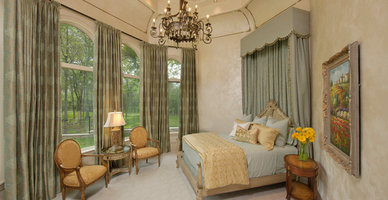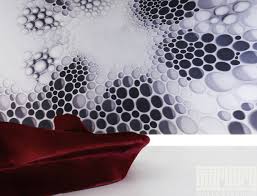Wallcoverings Wallpaper History
The story of wallpaper itself actually began in ancient China, first because the Chinese invented paper, and secondly because they glued rice papers onto their walls as early as 200 BC. The Chinese adorned rice paper panels with hand-painted with birds, flowers, religious symbols and landscapes.
By the Middle Ages, the European upper-class were hanging woven tapestries to keep out cold and dampness and to add color and design to otherwise dreary dwellings.
Wallpaper in a form we might recognize today, emerged when Louis XI of France ordered 50 rolls of paper painted by Jean Bourdichon in 1481. The design featured angels on a blue ground. King Louis ordered the portable wallpaper because he found it necessary to move frequently from castle to castle. Other well-heeled Europeans commissioned artists to paint paper for their walls, but real wallpaper can hardly be said to have existed till the advent of the printing press.
The earliest know fragment of European wallpaper was found on the beams of the Lodge of Christ's College in Cambridge, England and date from about 1509. A guild of paperhangers was established in France in 1599, but only small sheets of decorated paper were available.
The turning point for the product came in the early 1700s as Frenchman Jean-Michel Papillon, considered the inventor of wallpaper, designed wallpaper with repeating patterns.
The manufacturing methods developed by the British are significant, and the products from 18th century London workshops became all the rage. At first, fashion-conscious Londoners ordered expensive hand-painted papers that imitated architectural details or materials like marble and stucco, but eventually wallpapers won favor on their own merits.
Borders resembling a tasseled braid or a swag of fabric were often added, and flocked papers that looked like cut velvet were immensely popular. The beloved flocked variety your grandmother used throughout the house was developed at the beginning of the 18th century as a substitute for cut velvet.
Flocked walls even made it to Hampton Court to bear witness to Queen Victoria and Albert's romance. In 1839, the British invented a four-color roller printing machine with designs hand-cut on cylinders that could print 400 rolls a day.
Wallpaper came to America about 1739 when Plunket Fleeson began printing it in Philadelphia. By the 1800s, scenic papers printed with hand-carved blocks - some taking as many as 4,000 blocks to produce - were popular. In early America, colonials copied European fashions.
After the Revolutionary War, Americans set up workshops of their own. Paper was all the fashion, from neoclassical looks to rambling roses. American firms made their share of patriotic "commemorative" papers, which we have come to know from trunk linings and bandboxes.
The Victorian Era, as one would expect, was a grand time for wallpaper featuring over-embellished designs featuring somber colors, but it was in the roaring '20s that wallpaper really took the spotlight for the first time. Known as the Golden Age of Wallpaper, some 400 million rolls were sold during that period.
In the Victorian era, rooms paraded print upon print, mostly in garish colors, and the advent of machine-made wallpaper put the cabbage rose and arabesque patterns within the budget range of practically every home. Artisans such as Louis Comfort Tiffany and William Morris and their lyrical interpretations of nature, hand-printed by the wood block method, came to symbolize Art Nouveau.
After World War II, the entire industry was revolutionized with the appearance of plastic resins which offered stain resistance, washability, durability and strength. In addition, manufacturers introduced pre-pasted, pre-trimmed and strippable wallcoverings to cater to an increasing do-it-yourself market.
Modernism frowned on embellishments, so wallpaper fell into disfavor during much of this century. But as the 20th century ebbs and the bane of cookie-cutter homes and sterile work environments is upon us, we've rediscovered the romance and beauty of patterned walls.

 Wallcoverings Wallpaper
Wallcoverings Wallpaper Wallcoverings Wallpaper
Wallcoverings Wallpaper Wallcoverings Wallpaper
Wallcoverings Wallpaper Wallcoverings Wallpaper
Wallcoverings Wallpaper
The story of wallpaper itself actually began in ancient China, first because the Chinese invented paper, and secondly because they glued rice papers onto their walls as early as 200 BC. The Chinese adorned rice paper panels with hand-painted with birds, flowers, religious symbols and landscapes.
By the Middle Ages, the European upper-class were hanging woven tapestries to keep out cold and dampness and to add color and design to otherwise dreary dwellings.
Wallpaper in a form we might recognize today, emerged when Louis XI of France ordered 50 rolls of paper painted by Jean Bourdichon in 1481. The design featured angels on a blue ground. King Louis ordered the portable wallpaper because he found it necessary to move frequently from castle to castle. Other well-heeled Europeans commissioned artists to paint paper for their walls, but real wallpaper can hardly be said to have existed till the advent of the printing press.
The earliest know fragment of European wallpaper was found on the beams of the Lodge of Christ's College in Cambridge, England and date from about 1509. A guild of paperhangers was established in France in 1599, but only small sheets of decorated paper were available.
The turning point for the product came in the early 1700s as Frenchman Jean-Michel Papillon, considered the inventor of wallpaper, designed wallpaper with repeating patterns.
The manufacturing methods developed by the British are significant, and the products from 18th century London workshops became all the rage. At first, fashion-conscious Londoners ordered expensive hand-painted papers that imitated architectural details or materials like marble and stucco, but eventually wallpapers won favor on their own merits.
Borders resembling a tasseled braid or a swag of fabric were often added, and flocked papers that looked like cut velvet were immensely popular. The beloved flocked variety your grandmother used throughout the house was developed at the beginning of the 18th century as a substitute for cut velvet.
Flocked walls even made it to Hampton Court to bear witness to Queen Victoria and Albert's romance. In 1839, the British invented a four-color roller printing machine with designs hand-cut on cylinders that could print 400 rolls a day.
Wallpaper came to America about 1739 when Plunket Fleeson began printing it in Philadelphia. By the 1800s, scenic papers printed with hand-carved blocks - some taking as many as 4,000 blocks to produce - were popular. In early America, colonials copied European fashions.
After the Revolutionary War, Americans set up workshops of their own. Paper was all the fashion, from neoclassical looks to rambling roses. American firms made their share of patriotic "commemorative" papers, which we have come to know from trunk linings and bandboxes.
The Victorian Era, as one would expect, was a grand time for wallpaper featuring over-embellished designs featuring somber colors, but it was in the roaring '20s that wallpaper really took the spotlight for the first time. Known as the Golden Age of Wallpaper, some 400 million rolls were sold during that period.
In the Victorian era, rooms paraded print upon print, mostly in garish colors, and the advent of machine-made wallpaper put the cabbage rose and arabesque patterns within the budget range of practically every home. Artisans such as Louis Comfort Tiffany and William Morris and their lyrical interpretations of nature, hand-printed by the wood block method, came to symbolize Art Nouveau.
After World War II, the entire industry was revolutionized with the appearance of plastic resins which offered stain resistance, washability, durability and strength. In addition, manufacturers introduced pre-pasted, pre-trimmed and strippable wallcoverings to cater to an increasing do-it-yourself market.
Modernism frowned on embellishments, so wallpaper fell into disfavor during much of this century. But as the 20th century ebbs and the bane of cookie-cutter homes and sterile work environments is upon us, we've rediscovered the romance and beauty of patterned walls.
Wallcoverings Wallpaper

Wallcoverings Wallpaper
 Wallcoverings Wallpaper
Wallcoverings Wallpaper





Wallcoverings Wallpaper
 Wallcoverings Wallpaper
Wallcoverings Wallpaper
Wallcoverings Pittsburgh Stark Wallcoverings Silk Murals By Mark Balkovec
Wallpaper Instructions From Easywalls Wallcoverings and J & A Mark
No comments:
Post a Comment